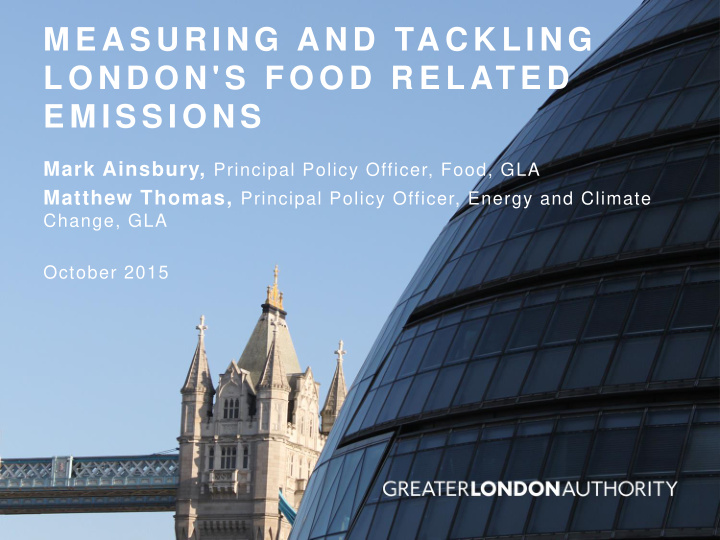



M E A S U R I N G A N D TA C K L I N G L O N D O N ' S F O O D R E L AT E D E M I S S I O N S Mark Ainsbury, Principal Policy Officer, Food, GLA Matthew Thomas, Principal Policy Officer, Energy and Climate Change, GLA October 2015
CONTENT • Greater London Authority – Context and stats • Introduction to food in London • Indirect emissions – PAS2070 and food • Measuring food emissions and why it’s important
LONDON GOVERNMENT • Greater London Authority (GLA) • Established in 1999 and now led by Mayor Boris Johnson • Responsible for strategic planning and sets budget for: – Transport for London – Metropolitan Police Authority – London Fire and Emergency Planning Authority – Olympic Legacy Development Corporation
33 LOCAL AUTHORITIES
SOME IMPORTANT STATS • 8.5m people • 1623 km 2 • 3.2 million homes • 432,000 businesses • GVA 22.2% of UK - grew by 4.0% in 2013 • Size of the economy = £338.4 billion • 5.6m jobs • ~40MtCO 2 6
T H E F O O D B O A R D H A S H E L P E D L O N D O N TO L E A D T H E WAY … www.london.gov.uk/sites/default/files/London's%20Food-Emissions.pdf
O U R F I R S T W O R K O N L O N D O N F O O D G H G E M I S S I O N S London’s Food Sector GHG Study 2008, by Brook Lyndhurst for Greater London Authority • Ground-breaking and thought-provoking - showed for first time nature and scale of food contribution to capital’s GHG emissions • Food was responsible at that time for 19 million tonnes CO 2 equivalent per annum (11 million of which CO 2 ) at every stage of food system: production to retail, food service, storage, preparation and disposal • Inspired us to commission work on Scope 3 (Indirect) Emissions to find out more about London’s wider food impacts
THE PAS 2070 data.london.gov.uk
WHAT IS PAS 2070? • A robust and transparent method for consistent, comparable and relevant quantification, attribution and reporting of city-scale greenhouse gas (GHG) emissions • Applicable to any city/urban area, worldwide • Uses two different but complementary methods: – Direct plus supply chain – Consumption based
EMISSION BOUNDARIES
TOTAL EMISSIONS Food and Food and drink: 13% drink: 10%
ECONOMIC FINAL CONSUMPTION • Cradle to gate GHG emissions: Includes GHG emissions from supply of food and drink consumed by city residents only. Consumption by visitors to the city is excluded (balanced by the inclusion of consumption by residents when they are outside of the city) Assumes GHG emissions from the food and drink life cycles correlate well with expenditure on food and drink.
…WHICH CONTAINS • Commercial food production – Identify farmed area and number of livestock – Disaggregate farmed area by crop type • Non-commercial – Identify all growing spaces in London – Assume area used for growing (number, size, % used for growing) – Identify common types of home grown crops and assume average yield factors
EMISSIONS All data, calculations and assumptions available on London Datastore. Search Application of PAS2070
EMISSIONS IN DETAIL
SO WHAT? • Results can be used by the GLA and Food Board to: – Focus resources on working with key food sectors – Influence policy such as the London Plan – Provide evidence to communicate to consumers and influence practice • Importance of household consumption
N E X T S T E P S : A G L O B A L U R B A N F O O D P O L I C Y • London aims to lead the way with cities around the world • We are working with the C40 Cities Climate Leadership Group, and with the City of Milan (host of EXPO 2015) on an Urban Food Policy Pact – a world food policy for cities – involving dozens of cities across the globe • We are basing our discourse on food policies on three axes: nutrition, environment and access to food. • Pact launched earlier this year as part of finale of Expo 2015
NEXT STEPS: LOCAL • In early 2016 we aim to study one London borough in more detail to: – provide an up to date assessment of the food Ecological Footprint and carbon emissions; – undertake research in the Borough to complete a comprehensive ‘food mapping and access’ analysis of existing outlets, households, flows and nodes; – model and build scenarios of what would need to be done to reduce food carbon emissions and Footprints by X amounts over a 5, 10, 15 and 20 year period, including food ‘infrastructure’
Thank you Mark.ainsbury@london.gov.uk Matthew.thomas@london.gov.uk
Recommend
More recommend